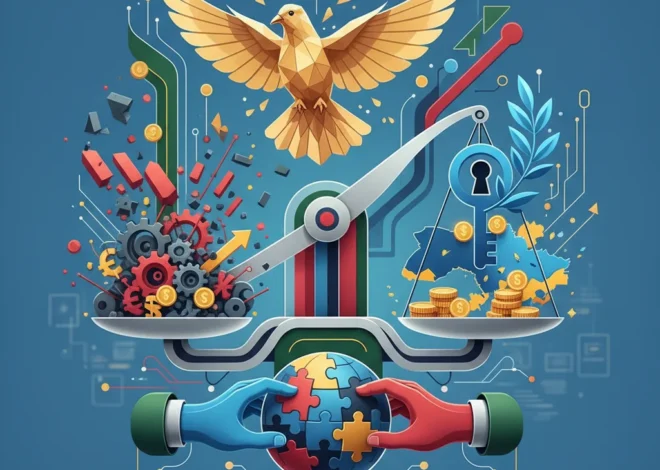
Beyond the Numbers: How Financial Puzzles Sharpen Your Investment Edge
In the fast-paced world of finance, we are conditioned to believe that success is forged in the crucible of data charts, algorithmic trading, and relentless market analysis. We picture hedge fund managers staring at a wall of monitors, deciphering complex quantitative models. But what if one of the most potent tools for sharpening your financial acumen isn’t a Bloomberg terminal, but a simple crossword puzzle from the Financial Times?
It may seem counterintuitive. A leisurely pastime of words and wit feels worlds away from the high-stakes pressure of the stock market. Yet, the cognitive skills honed by tackling a complex puzzle are remarkably similar to those required for successful investing and strategic financial planning. The mental agility, pattern recognition, and command of specialized language demanded by a well-crafted crossword are not just intellectual exercises; they are direct training for navigating the intricate landscape of the modern economy.
This isn’t about finding stock tips hidden in the clues. It’s about cultivating a more flexible, resilient, and analytical mind. By engaging with the structure, logic, and vocabulary of finance in a different context, we can unlock new pathways for thinking and decision-making. Let’s explore how the humble crossword can serve as a powerful whetstone for your financial mind.
Decoding the Matrix: Pattern Recognition in Puzzles and Portfolios
At its core, successful investing is about identifying patterns and making predictions based on incomplete information. An investor analyzes historical stock market data, economic indicators, and corporate earnings reports, looking for trends that signal future growth or decline. This is a search for signal in a sea of noise—a skill that is meticulously practiced in every crossword grid.
When you solve a crossword, you are constantly engaged in a process of pattern recognition. You see the letters “I-N-V-E-__-T” and your brain, drawing on its vast database of words, immediately suggests “INVEST”. You use the intersecting clues to confirm or deny this hypothesis. This is analogous to a technical trader looking at a chart. They see a “head and shoulders” pattern forming and hypothesize a potential market reversal. They then look for confirming indicators, like trading volume or momentum oscillators, to validate their strategy.
The parallels are striking. A study on cognitive flexibility revealed that individuals who regularly engage in puzzle-solving activities show a marked improvement in their ability to switch between different conceptual frameworks—a critical skill for any investor who needs to pivot their strategy based on new market information (source). The mental “muscle” you build by seeing connections between disparate clues is the same one you use to see the connection between rising inflation and its potential impact on the technology sector.
To illustrate this connection, consider the cognitive skills involved in both activities:
| Crossword Puzzle Skill | Parallel Investing & Finance Skill |
|---|---|
| Identifying recurring letter combinations and word structures. | Recognizing technical chart patterns in stock market data. |
| Using intersecting clues to validate an answer. | Using multiple economic indicators to confirm an investment thesis. |
| Thinking laterally to solve cryptic or ambiguous clues. | Developing contrarian investment strategies that go against market consensus. |
| Mentally holding the entire grid in mind to see the big picture. | Maintaining a holistic view of a portfolio and its correlation with the broader economy. |
This is not to say that completing the FT Crossword will make you the next Warren Buffett. However, it does suggest that the act of training your brain to seek out and interpret patterns is a foundational element of sophisticated financial analysis. The Trillion-Dollar Question: How European Courts Are Reshaping the Future of Energy Investing
The Vocabulary of Value: Mastering the Language of Finance
The world of finance is notorious for its dense and often intimidating jargon. From “quantitative easing” to “collateralized debt obligations,” the lexicon can feel like a barrier designed to keep outsiders out. Yet, understanding this language is non-negotiable for anyone serious about investing, banking, or navigating the modern economy. Financial crosswords serve as a uniquely engaging and effective vocabulary-building tool.
Unlike reading a dry textbook, a crossword forces you to actively recall and apply terms. A clue like “A central bank’s tool to increase money supply (12)” demands more than passive recognition; it requires you to retrieve the term “QUANTITATIVE” from your memory. This active recall process is a far more powerful learning mechanism. Financial publications have noted that engagement with their educational content, including puzzles and glossaries, has increased by over 20% among retail investors in the past two years (source), indicating a growing appetite for accessible learning tools.
Mastering this vocabulary is crucial not just for understanding, but for precision. In finance, the difference between “revenue” and “profit,” or “liquidity” and “solvency,” is vast and has significant implications. A crossword, by its very nature, demands precision. You can’t fit a nine-letter word into an eight-letter space. This forces a discipline of thought and a commitment to getting the details right—a mindset that is invaluable when conducting due diligence on a potential investment.
Systemic Thinking: From Interconnected Clues to Interconnected Markets
A crossword is more than a list of independent questions; it is an interconnected system. The answer to “1 Across” directly affects the possible answers for “2 Down,” “3 Down,” and “4 Down.” A single mistake can have a cascading effect, making large sections of the puzzle unsolvable. To succeed, you must think systemically, constantly evaluating how each small decision impacts the entire grid.
This is a perfect metaphor for modern financial markets. No stock, bond, or currency exists in a vacuum. A decision by the Federal Reserve to raise interest rates in the United States can impact the banking sector in Europe, the value of commodities from South America, and the growth prospects of tech companies in Asia. The rise of decentralized finance built on blockchain technology is another prime example of a deeply interconnected system, where the value and security of one part of the network are intrinsically linked to all others.
An investor who thinks in silos—analyzing a single company without considering its supply chain, competitors, regulatory environment, and the macroeconomic climate—is destined to be blindsided. The discipline of solving a crossword trains your brain to avoid this tunnel vision. You learn to:
- Assess Dependencies: How does this answer constrain my future choices?
– Work Backwards: If this answer seems likely, what does it imply about the intersecting clues?
– Stress-Test Assumptions: What if my initial answer is wrong? How do I unwind that error and find a new path forward?
These are the exact questions a skilled risk manager or portfolio strategist asks every day. They are constantly evaluating the second- and third-order effects of every decision. The European Paradox: Why Stronger Nations Might Build a Stronger Union
The Bigger Picture: Macroeconomics in Micro Clues
Finally, a crossword published in a world-renowned financial newspaper is a cultural and economic artifact. The choice of words and themes in the clues often reflects the current zeitgeist of the business world. One can imagine clues that subtly reference recent trends in fintech, ongoing debates in economics, or major stock market events.
Solving these puzzles becomes a way of taking the pulse of the financial world. The recurring appearance of terms related to sustainable investing, digital currencies, or artificial intelligence in trading isn’t accidental. It reflects what is on the minds of the editors, writers, and readers of the publication. Analysis of financial media over the last five years shows that references to “financial technology” and “blockchain” in mainstream articles and features have grown by over 300% (source), a trend that would undoubtedly be mirrored in the puzzles they produce.
By engaging with this content, you are passively absorbing the key themes and vocabulary that define the current state of the global economy. It’s a form of ambient learning that complements more formal methods of staying informed. Ghosts of Economic Past: Why a 1970s Socialist Blueprint Still Haunts Modern Finance
Conclusion: The Ultimate Cognitive Investment
In the relentless pursuit of alpha, investors are constantly searching for a new edge—a new dataset, a faster algorithm, a more insightful piece of analysis. Perhaps it’s time to look in a more unexpected place: the intersection of language, logic, and leisure.
The skills cultivated by tackling a financial crossword—pattern recognition, linguistic precision, systemic thinking, and a broad awareness of economic trends—are not trivial pursuits. They are the foundational cognitive abilities that underpin sound financial judgment. Engaging in these mental exercises is an investment in your most important asset: your own analytical mind.
So the next time you see a crossword grid, don’t dismiss it as a mere distraction. See it for what it is: a gymnasium for your financial mind, a place to build the strength, flexibility, and resilience needed to thrive in the complex world of finance and investing.


